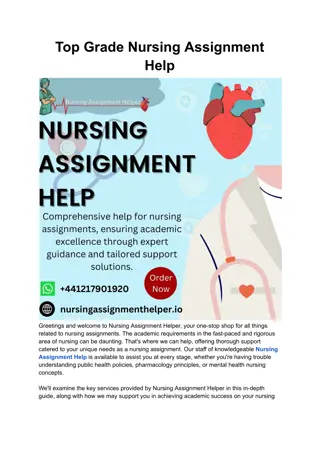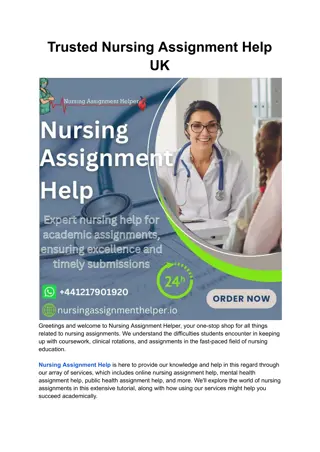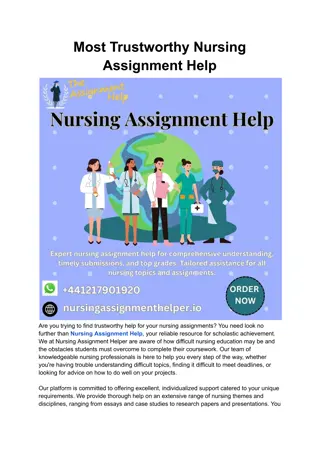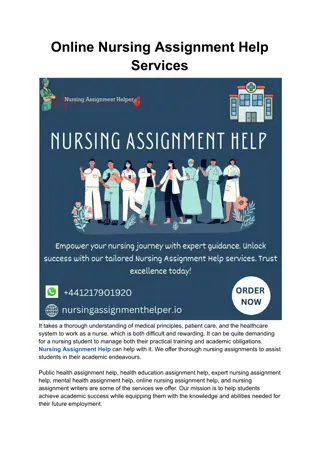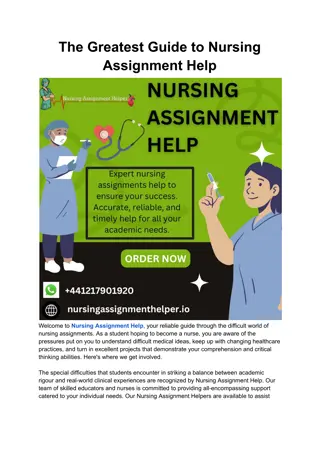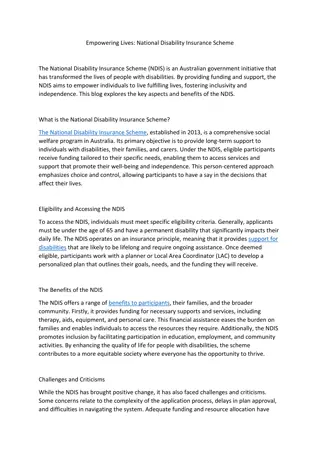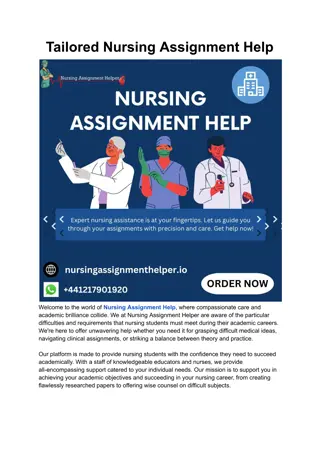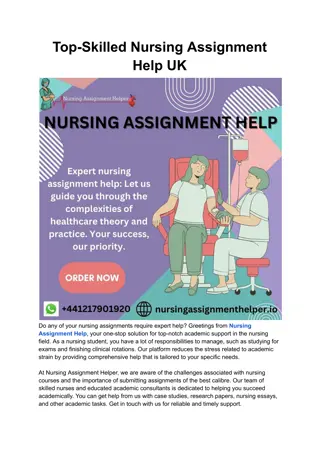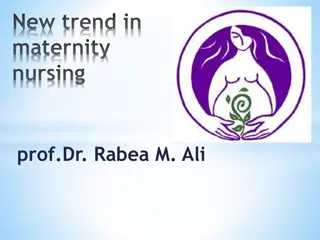Family Nursing & Home visit
Family health nursing focuses on maximizing the well-being of individuals within a family system. It involves promoting self-care abilities, protecting health, and integrating comprehensive planning tailored to family units. Emphasis is placed on the interconnectedness of family health and individual members, recognizing the family as a pivotal influence on health behaviors. This approach enhances the effectiveness of health care and contributes to the overall health of society.
Download Presentation

Please find below an Image/Link to download the presentation.
The content on the website is provided AS IS for your information and personal use only. It may not be sold, licensed, or shared on other websites without obtaining consent from the author. Download presentation by click this link. If you encounter any issues during the download, it is possible that the publisher has removed the file from their server.
E N D
Presentation Transcript
Family Nursing & Home visit ASSIST. PROF. WIPAKON SONSNAM
Difinition Nursing process is a critical thinking process that professional nurse use to apply the best available evidence to caregiving and promoting human functions and response to health and illness (American Nurses Association, 2010)
Family Meaning The family is a group of persons united by ties of marriage, blood or adoption, constituting a single household, interacting and communicating with each other in their respective social roles
Family Health Meaning Family health is a dynamic, changing, relative state of well-being which includes the biological, psychological, spiritual, sociological, and culture factors of the family system.
Family Health Nursing Definition and meaning of family health nursing Family health nursing is the practice of nursing directed towards maximizing the health and wellbeing of all individuals within in a family system. The goals of the family health nursing include optimal functioning for the individual and for the family as a unit.
Family Health Nursing Definition Family health nursing is a nursing aspect of organized family health care services which are directed or focused on family as the unit care with health as the goal. It is thus synthesis of nursing care and health care. It helps to develop self care abilities of the family and promote, protect and maintain its health. Family health nursing is generalized, well balanced and integrated comprehensive planning to accomplish its goal.
Need of Family Focus Health and illness behaviors are learned within the context of family. Family units are affected when one or more health members experience health problems. Families affect the health of individual members and viceversa. Health care effectiveness is improved when emphasis is placed on the family. Promotion, maintenance and restoration of the health of families is important to the survival of society.
Objectives To identify health and nursing needs and problems of each family. To ensure family s understanding and acceptance of those needs and problems. To plan and provide health and nursing services with active participation of family members. To help families develop ability to deal with their health needs and health problems independently. To contribute to family s performance of developmental functions and tasks.
Objectives To help family make intelligent use of facilities and services in the community. To educate, counsel and guide family members.
Principles Family health nursing is family focused. Must establish good working relationship with the family. Family health nursing is part of family health care services. Family health nursing services should be realistic in terms of resources available.
Principles Family as a unit is responsible for their members health. Family relates to community where it lives and depends on community in various way. Health education, guidance and supervision are integral part of family health nursing. Continuous services are effective services.
Roles of Family Nursing 1. Health teacher (Health educator) 2. Coordinator, collaborator 3. Deliverer and supervisor of care and technical expert 4. Family advocate 5. Counselor 6. Case finder and epidemiologist
Roles of Family Nursing 7. Environmental modifier 8. Clarifier and interpreter 9. Researcher 10.Role model 11.Case manager
Family centered nursing appaoch There are four approaches or ways to view families that have legitimate implication for nursing assessment and intervention. The four approaches included in the family health nursing care view are:
Approaches to Family Nursing Family as the context Individual as foreground Family as background
Family as the context When the nurse views the family as context, the primary focus is on the health and development of an individual member existing within a specific environment (i.e., the client s family). Although the nurse focuses the nursing process on the individual s health status, the nurse also assesses the extent to which the family, their ability to help the client meet psychological needs must also be considered. Provides the individual s basic needs.
Approaches to Family Nursing Family as the client Family as foreground Individual as background
Family as the client Family as the client The family is the foreground and individuals are in the background. The family is seems as the sum of individuals family members. The focus is concentrated on each and every individual as they affect the whole family. From this perspective, a nurse might ask a family member who has just become ill. Tell me about what has been going on with your own health and how your perceive each family member responding to your mother s recent diagnosis of live cancer.
Approaches to Family Nursing Family as System Interactional Family
Family as System Family as System The focus is on the family as a client and it is viewed as an international system in which the whole is more than the sum of its parts. This approach focuses on the individual and family members become the target for nursing interventions. :The direct interaction between the parent and the child
Approaches to Family Nursing Family as Component of Society Hospital + wat + Bank + Schools + Family/Home
Family as Component of Society Family as Component of Society The family is seen as one of many institutions in society, along with health, educational, religious, or economic institution. The family is a basic or primary unit of society, as are all the other units and they are all a part of the larger system of society. The family as a whole interacts with other institutions to receive exchange or give communications and services. Community health nursing has drawn many of its clients from this perspective as it focuses on the interface between families and communities.
Family Nursing Process Carnevali and Thomas, 1993 1. Collection of a family data base (general or focused) 2. Diagnostic reasoning and generation of specific family nursing diadnosis 3. Collection of prognostic nursing and medical data and generation of data-supported nursing prognosis for each family nursing diagnosis.
Family Nursing Process 4. Treatment planning base on both family nursing diagnosis and prognosis, plus additional data on daily living and family resources/deficits should affect planned nursing actions. 5. Implementation of family-negotiated plans of action 6. Evaluation of family/family members, responses to plans action, effects of family diagnosis, prognosis, and previous treatment (base on family outcomes) .
Family Nursing Process 7. Termination of the nurse family partnership is included in the plan of action and is implemented based on the evaluation
Method of data collection Observation: method of data collection through the use of sensory capacities, sight, hearing, smell and touch. Data gathered through this method have the advantage of being subjected to validation and reliability and reliability testing by other observers. Physical Examination: done through inspection, palpation, percussion, auscultation, measurement of specific body parts and reviewing the body systems. Interview: completing the health history of each family member.
Method of data collection Record Review: reviewing existing records and reports pertinent to the client. (Individual clinical records of the family members; laboratory & diagnostic report; immunization record; reports about the home & environmental conditions. Laboratory/Diagnostic Tests: performing laboratory tests, diagnostic procedures or other tests of integrity and functions carried out by the nurse herself and/or other health workers.
Tool of collecting data Genogram 3 generation Ecogram Family APGAR Score (FAPGAR) (Smilkstein, 1984); -A: Adaptation -P: Partnership -G: Growth -A: Affective -R: Resolve (commitment)
Family Plan Main component -Priority setting -Goal -Activities
Priority setting Main component 3 1. The severity of the problem 2. Problem solving ability 3. Attention / Participation
Evaluation Friedman, Bowden & Jones, 2003; 1.Both evaluation are accepted 2. Other information needed for evaluation 3.What the reason to family s behavior or perception in solving the problem not satisfactory 4. Accurate and Practical of Nursing diagnosis, Goal, and Nursing activities
Type of Evaluation , 2553 1. Formative Evaluation 2. Summative Evaluation
Home visit The importance of home visit 1. Appropriate care and continuous 2. Has been taken care of since the beginning 3. Give advice according to problems and needs 4. Received nursing practice 5. Received warmth and support from community nurse
Home visit 1. True data of the family 2. True problem and Needs 3. True community data that cause of health problems
Stage of Home Visit 1. Pre-stage of home visit -self-preparing, family folder, equipment ect. -priority setting of home visit
Stage of Home Visit 2. Implement -make a relationship -assessment -care -conclusion and reviewthen make an appointment
Stage of Home Visit 3. After of home visit -report data in family folder
Principle of priority setting to home visit 1. Urgency (first visit) 2. Prevention of disease spread (last visit)
Criterion to visit 1. Families with members in their growing years, more change status of health, deteriorated 2. Family with members in illness / disease (current/chronic) 3. Family with members in crisis 4. Family withlack of knowledge, attitude, health behavior








